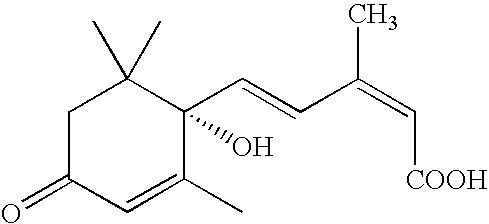Salts, Aqueous Liquid Compositions Containing Salts of S-(+)-Abscisic Acid and Methods of Their Preparation
a technology of abscisic acid and salts, which is applied in the field of salts of (s)(+)abscisic acid, can solve the problems of not revealing the combinations of common salts, young tissues with high abscisic acid levels, and severe stunting of abscisic acid-deficient mutant plants, so as to enhance the biological activity of the salts
- Summary
- Abstract
- Description
- Claims
- Application Information
AI Technical Summary
Benefits of technology
Problems solved by technology
Method used
Image
Examples
example 1
Preparation of an Aqueous Solution Composition Comprising the Rubidium Salt of (S)-(+)-Abscisic Acid
[0045]Tween 20 (25 mg), trisodium citrate dihydrate (125 mg) and sodium metabisulfite (62.5 mg) were dissolved in 10 mL of deionized water. (S)-(+)-Abscisic acid (2.64 g of 95% purity) was added, and the mixture was stirred until a smooth suspension was obtained. The solution was titrated with a 50% aqueous solution of rubidium hydroxide to a final pH of 6.8, monitoring with a pH meter, which produced a clear, colorless solution. The solution was then diluted with deionized water to a total weight of 25 g and stored in a brown bottle.
[0046]Thus a composition was prepared comprising 10.0% (S)-(+)-abscisic acid by weight as the rubidium salt and further comprising sodium citrate and sodium bisulfite as stability enhancing additives.
example 2
Preparation of an Aqueous Solution Composition Comprising the Cesium Salt of (S)-(+)-Abscisic Acid
[0047]Tween 20 (25 mg), trisodium citrate dihydrate (164 mg) and sodium metabisulfite (62.5 mg) were dissolved in 10 mL of deionized water. (S)-(+)-Abscisic acid (2.64 g of 95% purity) was added, and the mixture was stirred until a smooth suspension was obtained. A 50% aqueous solution of cesium hydroxide was added dropwise with good stirring until all of the abscisic acid was brought into solution. The final pH was 6.96. The solution was made up with deionized water to 25.0 g total weight and stored in a brown bottle.
[0048]Thus a composition was prepared comprising 10.0% abscisic acid by weight as the cesium salt and further comprising sodium citrate and sodium bisulfite as stability enhancing additives.
example 3
Preparation of an Aqueous Solution Composition Comprising the Tetramethylammonium Salt of (S)-(+)-Abscisic Acid
[0049](S)-(+)-Abscisic acid (2.64 g of 95% purity) was suspended in 10 mL of deionized water in which was dissolved 25 mg of Tween 20, 125 mg of trisodium citrate dihydrate and 62.5 mg of sodium metabisulfite. The mixture was titrated to neutrality (pH 7.0) with a 1.0 molar aqueous solution of tetramethylammonium hydroxide, which resulted in a clear colorless solution. The solution was made up with deionized water to a total weight of 25.0 g and stored in a brown bottle.
[0050]Thus a composition was prepared comprising 10.0% abscisic acid by weight as the tetramethylammonium salt and further comprising sodium citrate and sodium bisulfite as stability enhancing additives.
PUM
| Property | Measurement | Unit |
|---|---|---|
| weight % | aaaaa | aaaaa |
| weight % | aaaaa | aaaaa |
| solubility | aaaaa | aaaaa |
Abstract
Description
Claims
Application Information
 Login to View More
Login to View More - R&D
- Intellectual Property
- Life Sciences
- Materials
- Tech Scout
- Unparalleled Data Quality
- Higher Quality Content
- 60% Fewer Hallucinations
Browse by: Latest US Patents, China's latest patents, Technical Efficacy Thesaurus, Application Domain, Technology Topic, Popular Technical Reports.
© 2025 PatSnap. All rights reserved.Legal|Privacy policy|Modern Slavery Act Transparency Statement|Sitemap|About US| Contact US: help@patsnap.com


